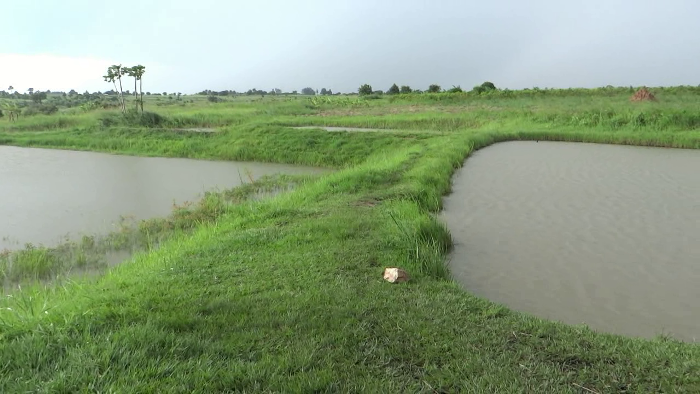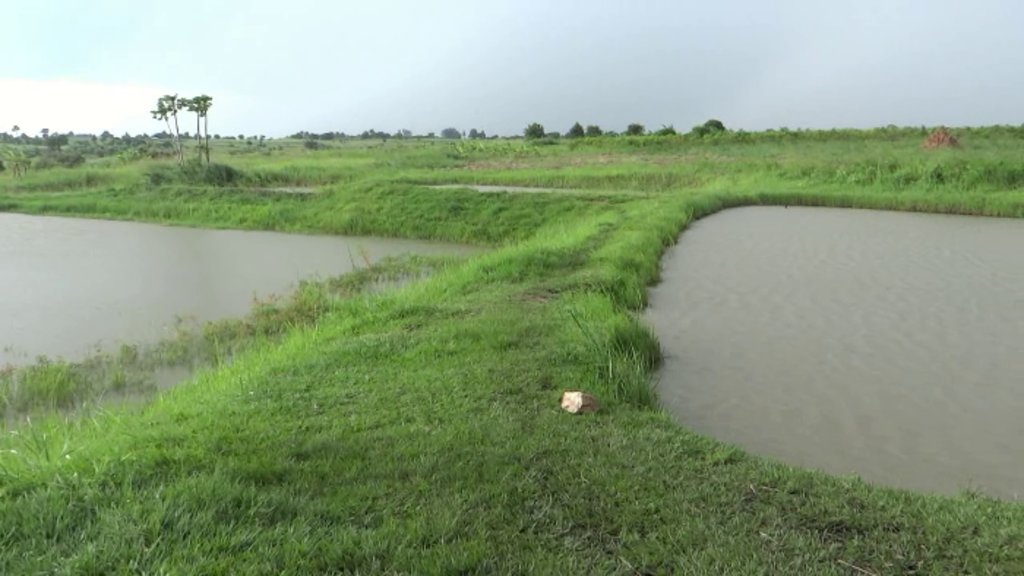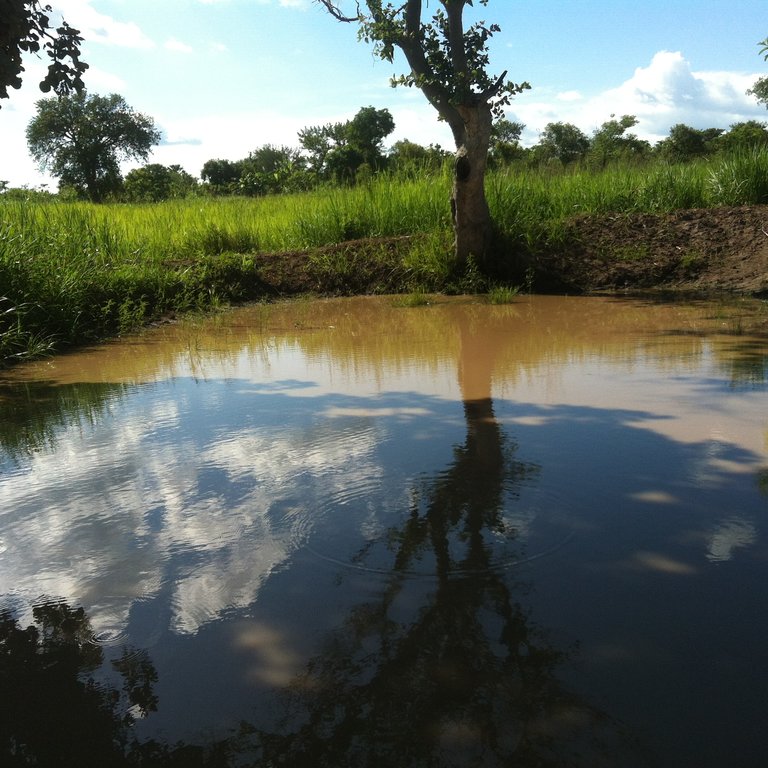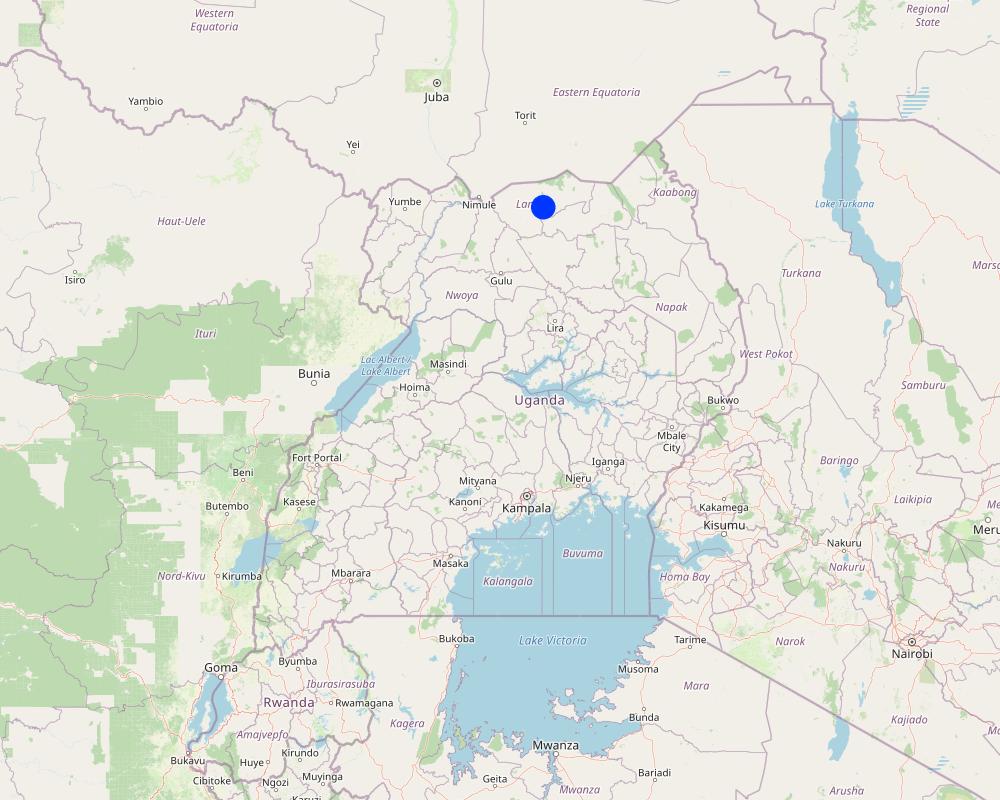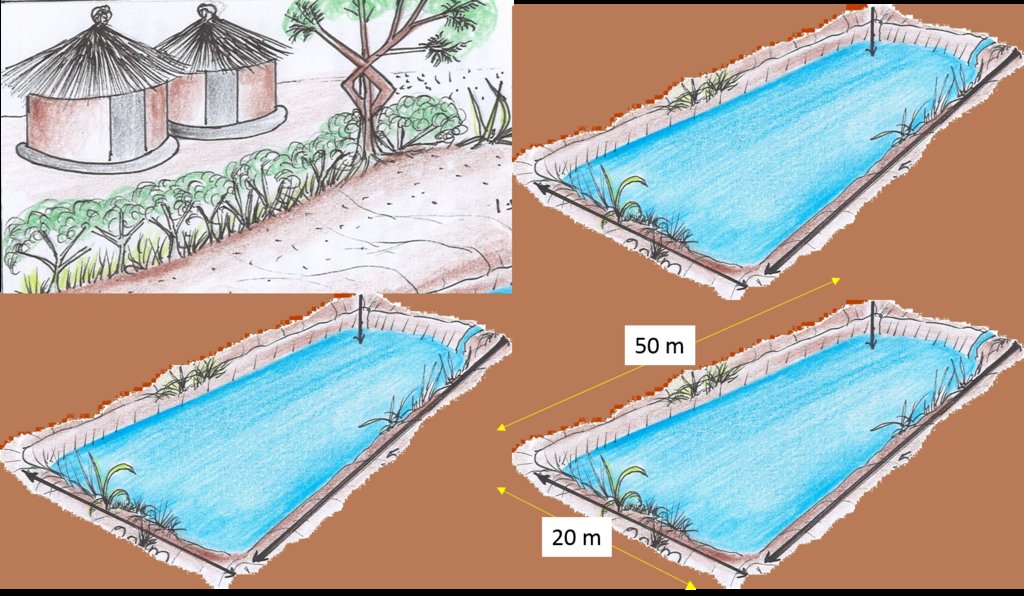Ground water fed fish ponds [اوغندا]
- تاريخ الإنشاء:
- تحديث:
- جامع المعلومات: Kamugisha Rick Nelson
- المحررون: JOY TUKAHIRWA, Richard Otto Kawawa, Bernard Fungo
- المراجعون: Donia Mühlematter, John Stephen Tenywa, Nicole Harari, Renate Fleiner, Stephanie Jaquet, Alexandra Gavilano, Joana Eichenberger
Pii it Pi Gwooko Rec
technologies_2796 - اوغندا
عرض الأقسام
توسيع الكل طي الكل1. معلومات عامة
1.2 تفاصيل الاتصال بالأشخاص الرئيسيين لمصدر المعلومات والمؤسسات المشاركة في تقييم وتوثيق التقنية
الشخص (الأشخاص) الرئيسي لمصدر المعلومات
مستخدم الأرض:
Okot Parikinson
Commercail farmer
اوغندا
اسم المشروع الذي سهّل توثيق/تقييم التقنية (إذا كان ذلك على صلة)
Scaling-up SLM practices by smallholder farmers (IFAD)اسم المؤسسة (المؤسسات) التي سهلت توثيق/تقييم التقنية (إذا كان ذلك على صلة)
CDE Centre for Development and Environment (CDE Centre for Development and Environment) - سويسرا1.3 الشروط المتعلقة باستخدام البيانات الموثقة من خلال WOCAT
يوافق جامع المعلومات والشخص (لاشخاص) الرئيسي لمصدر المعلومات على الشروط المتعلقة باستخدام البيانات الموثقة من خلال WOCAT:
نعم
1.4 إعلان بشأن استدامة التقنية الموصوفة
هل التقنية الموصوفة هنا تمثل مشكلة فيما يتعلق بتدهور الأراضي، بحيث لا يمكن إعلانها تقنية مستدامة لإدارة الأراضي؟:
كلا
التعليقات:
A high water table is favourable for digging shallow water wells for irrigation of cropland which increases production during the dry season.
2. وصف تقنيةالإدارة المستدامي للأراضي
2.1 وصف مختصر للتقنية
تعريف التقنية:
Fish farming supported by availability of water is considered as profitable enterprise in Northern Uganda. Farmers use areas with either high water tables or swamps to locate the ground water recharged fish ponds and water for fish production and crop irrigation during the dry season.
2.2 وصف تفصيلي للتقنية
الوصف:
Fish farming is a sustainable land management agricultural practice promoted by farmers on medium sized farms in Northern Uganda, where ground water supply in wetland is used to recharge at least three adjacent fish ponds for fish production during the wet and dry season with each pond established measuring 50 m long x 20 m wide and 1.5 m depth with the following inputs hoes, spades, panga, wheel barrow, feeds and labour. The sides of the ponds are grown with grassy vegetation to stabilize soil, as well as feed the fish. It is, therefore imperative that farmers who want to invest in such sustainable land management practice first seek professional advice from extension agents or from other experienced farmers, on post-harvest fish handling and preservation. In Northern Uganda, fish theft and poisoning are also rampant, especially where ponds are not properly guarded or fenced. The most costly aspects of pond fish farming include pond excavation, laboratory testing of water and surrounding soil properties; procurement of fries especially tilapia, fencing and procurement of fish feeds. The average cost of establishing each pond is approximately US$428; while putting fish firies establishment goes for an average of US$ 71 per pond.
It is important to note that at the beginning the capital investments are high; these include paying for construction and buying fish fries to put in the ponds. However, in the long term the benefits exceed the costs. This is because fish farming is a high value enterprise with potential to provide household food, nutrition and income security.
2.3 صور التقنية
2.4 فيديوهات عن التقنية
تعليقات، وصف موجز:
Video on Ground water fish ponds in Lamwo District.
التاريخ:
12/0/2017
الموقع:
Lamwo District
اسم مصور الفيديو:
Issa Aiga
2.5 البلد/المنطقة/المواقع التي تم تنفيذ التقنية فيها والتي يغطيها هذا التقييم
البلد:
اوغندا
المنطقة/الولاية/المحافظة:
Northern Region,Uganda
مزيد من التفاصيل حول الموقع:
Lamwo District
حدد انتشار التقنية:
- يتم تطبيقها في نقاط محددة/ تتركز على مساحة صغيرة
التعليقات:
Map showing technology site in Northern Uganda.
Concentrated in a wetland.
Map
×2.6 تاريخ التنفيذ
اذكر سنة التنفيذ:
2000
في حالة عدم معرفة السنة بالتحديد، يرجى الإشارة إلى التاريخ التقريبي:
- منذ 10-50 سنة
2.7 إدخال التقنية
حدد كيف تم إدخال التقنية:
- من خلال ابتكار مستخدمي الأراضي
- من خلال المشاريع/ التدخلات الخارجية
التعليقات (نوع المشروع، الخ):
Received training from the extension agent.
3. تصنيف تقنية الإدارة المستدامي للأراضي
3.1 الغرض الرئيسي ( الأغراض الرئيسية) للتقنية
- تحسين الإنتاج
- خلق أثر اقتصادي مفيد
3.2 نوع (أنواع) استخدام الأراضي الحالية حيث يتم تطبيق التقنية

الأراضي الزراعية
- زراعة سنوية
الزراعة السنوية - حدد المحاصيل:
- الحبوب - الذرة
عدد مواسم الزراعة في السنة:
- 2
حدد:
Harvest twice a year (May and December).

أراضي الرعي
نوع الحيوان:
- الماشية -لإنتاج اللحوم وليس للألبان
- cows, fish: Nile perch, tilapia and wild fish
الصنف:
الماعز
العدد:
5
الصنف:
الماشية -لإنتاج اللحوم وليس للألبان
العدد:
4

المجاري المائية، المسطحات المائية، الأراضي الرطبة
- المستنقعات والأراضي الرطبة
المنتجات / الخدمات الرئيسية:
Fish fingers
3.3 هل تغير استخدام الأراضي نتيجة لتنفيذ التقنية؟
التعليقات:
Land was under maize plantation, which was usually planted within one year before the implementation of the technology.
3.4 إمدادات المياه
إمدادات المياه للأرض التي يتم تنفيذ التقنية عليها:
- بعلية
3.5 مجموعةالإدارة المستدامة للأراضي التي تنتمي إليها هذه التقنية
- إدارة المياه السطحية (الينابيع، الأنهار، البحيرات، البحار)
- تربية النحل، واستزراع الأسماك، والدواجن، وتربية الأرانب، وتربية دودة القز، الخ.
3.6 التدابير التقنية في مجال إلادارة المستدامة للأراضي

التدابير الزراعية
- A1: الغطاء النباتي/التربة
- A2: المادة العضوية/خصوبة التربة

التدابير النباتية
- V2: الأعشاب والنباتات العشبية المعمرة
- V3: إزالة الغطاء النباتي

التدابير البنيوية
- S5: السدود، الأحواض الصغيرة، البرك

التدابير الإدارية
- M1: التغيير في نوع استخدام الأراضي
التعليقات:
Grasses are allowed to grow to stabilise the levees.
3.7 الأنواع الرئيسية من تدهور الأراضي التي تناولتها التقنية

التدهور البيولوجي
- (Bh): فقدان الموائل
- (Bp): زيادة الآفات/الأمراض، وفقدان الحيوانات المفترسة

تدهور المياه
- (Hs): التغيير في كمية المياه السطحية
- (Hp): تدهور نوعية المياه السطحية

آخر
التعليقات:
Vegetation around the pond stabilize the soils which reduces erosion.
3.8 منع أو حد أو عكس تدهور الأراضي
تحديد هدف التقنية فيما يتعلق بتدهور الأراضي:
- اصلاح/إعادة تأهيل الأراضي المتدهورة بشدة
التعليقات:
Due to vegetation growth around the fish ponds.
4. المواصفات الفنية، وأنشطة التنفيذ، والمدخلات، والتكاليف
4.1 الرسم الفني للتقنية
المواصفات الفنية (المتعلقة بالرسم الفني):
Using 6 people paid on daily basis the farmer digs a three adjacent fish ponds either in a wetland on an average land size of less than 0.5 acres each water fed fish pond measuring 50 m long x 20 m wide dug to a depth of not more than 1.5 m. to allow water passively replenishes the pond, The Species kept are Nile perch, tilapia and wild fish.
المؤلف:
Kaheru
التاريخ:
01/02/2018
4.2 معلومات عامة بخصوص حساب المدخلات والتكاليف
حدد كيفية احتساب التكاليف والمدخلات:
- حسب مساحة تنفيذ التقنية
الإشارة إلى حجم ووحدة المساحة:
0.5 acres
عملة أخرى/ عملة وطنية (حدد):
UGX
إذا كان ذا صلة، وضح سعر الصرف من الدولار الأمريكي إلى العملة المحلية (على سبيل المثال، 1 دولار أمريكي = 79.9 ريال برازيلي): 1 دولار أمريكي =:
3500,0
اذكر متوسط تكلفة أجر العمالة المستأجرة في اليوم الواحد:
5000 per person per day
4.3 أنشطة التأسيس
| النشاط | التوقيت (الموسم) | |
|---|---|---|
| 1. | Excavation of soil for ponds | During the dry season |
| 2. | Soil testing | During the dry season |
| 3. | Water testing | Routine, dry and wet season |
| 4. | Buying fries | Dry and wet season |
| 5. | Stocking the fish | Wet season and dry season |
| 6. | Feeding | Dry and wet season |
| 7. | Planting around the pond | Dry and wet season |
التعليقات:
Planted vegetation can also be used as feed supplement.
4.4 التكاليف والمدخلات اللازمة للتأسيس
| تحديد المدخلات | الوحدة | الكمية | التكاليف لكل وحدة | إجمالي التكاليف لكل مدخل | % من التكاليف التي يتحملها مستخدمو الأراضي | |
|---|---|---|---|---|---|---|
| العمالة | Monthly persons days | persons | 6,0 | 150000,0 | 900000,0 | 100,0 |
| معدات | Hoes | pieces | 6,0 | 10000,0 | 60000,0 | 100,0 |
| معدات | Spade | peices | 3,0 | 10000,0 | 30000,0 | 100,0 |
| معدات | panga | pieces | 3,0 | 10000,0 | 30000,0 | 100,0 |
| معدات | Wheel barrow | piece | 2,0 | 250000,0 | 500000,0 | |
| غير ذلك | Fish fries for 3 ponds | fries | 3000,0 | 1000,0 | 3000000,0 | 100,0 |
| غير ذلك | Soil tests | 1 | 2,0 | 350000,0 | 700000,0 | 100,0 |
| غير ذلك | water tests | 1 | 2,0 | 380000,0 | 760000,0 | 100,0 |
| إجمالي تكاليف إنشاء التقنية | 5980000,0 | |||||
| إجمالي تكاليف إنشاء التقنية بالدولار الأمريكي | 1708,57 | |||||
التعليقات:
Soil and water tests are done twice before establishment and once after establishment.
4.5 الصيانة/الأنشطة المتكررة
| النشاط | التوقيت/الوتيرة | |
|---|---|---|
| 1. | Slashing | twice a year |
| 2. | Feeding | Routine |
4.6 التكاليف والمدخلات اللازمة للصيانة/للأنشطة المتكررة (سنويًا)
| تحديد المدخلات | الوحدة | الكمية | التكاليف لكل وحدة | إجمالي التكاليف لكل مدخل | % من التكاليف التي يتحملها مستخدمو الأراضي | |
|---|---|---|---|---|---|---|
| العمالة | Persons days for feeding and slashing/ monthly | Persons | 1,0 | 150000,0 | 150000,0 | 100,0 |
| غير ذلك | Feeds monthly | Kilograms | 15,0 | 4000,0 | 60000,0 | |
| إجمالي تكاليف صيانة التقنية | 210000,0 | |||||
| إجمالي تكاليف صيانة التقنية بالدولار الأمريكي | 60,0 | |||||
التعليقات:
Low costs for paying labour due to reduced workload.
Also equipment like hoe , spade, panga are purchased at the time of establishment so no need to incur more costs. Additional costs are incurred when they wear out. At the time of the interview, the land user had not incurred costs on buying tools for maintaining the technology.
4.7 أهم العوامل المؤثرة على التكاليف
قدم وصفا لأهم العوامل التي تؤثر على التكاليف:
Labour for establishing and maintaining the pond.
5. البيئة الطبيعية والبشرية
5.1 المناخ
هطول الأمطار السنوي
- < 250 مم
- 251- 500 ملم
- 501 - 750ملم
- 1,000-751 ملم
- 1,500-1,100 ملم
- 2,000-1,500 ملم
- 3,000-2,001 ملم
- 4,000-3,100 ملم
- > 4000 ملم
حدد متوسط هطول الأمطار السنوي (إذا كان معروفًا)، بالملليمتر:
1250,00
المواصفات/التعليقات على هطول الأمطار:
Two rainy season and two dry season- Bi modal.
المنطقة المناخية الزراعية
- رطبة
5.2 طوبوغرافيا
متوسط الانحدارات:
- مسطح (0-2%)
- بسيط (3-5%)
- معتدل (6-10%)
- متدحرج (11-15%)
- تلال (16-30%)
- شديدة الانحدار(31-60%)
- فائقة الانحدار (>60%)
التضاريس:
- هضاب/سهول
- أثلام مرتفعة
- المنحدرات الجبلية
- منحدرات التلال
- منحدرات في السفوح
- قاع الوادي
المنطقة الارتفاعية:
- 100-0 متر فوق سطح البحر
- 500-101 متر فوق سطح البحر
- 1,000-501 متر فوق سطح البحر
- 1,500-1,001 متر فوق سطح البحر
- 2,000-1,501 متر فوق سطح البحر
- 2,500-2,100 متر فوق سطح البحر
- 3,000-2,501 متر فوق سطح البحر
- 4,000-3,001 متر فوق سطح البحر
- > 4000 متر فوق سطح البحر
وضح ما إذا كانت التقنية مطبقة على وجه التحديد في:
- حالات مقعرة
التعليقات والمواصفات الإضافية بشأن التضاريس:
Situated in the wetland.
5.3 التربة
متوسط عمق التربة:
- ضحل جدًا (0-20 سم)
- ضحلة (21-50 سم)
- متوسطة العمق (51-80 سم)
- عميقة (81-120 سم)
- عميقة جدًا (> 120 سم)
قوام التربة (التربة السطحية):
- متوسط ( طميي، سلتي)
قوام التربة (> 20 سم تحت السطح):
- متوسط ( طميي، سلتي)
المواد العضوية في التربة السطحية:
- متوسطة (1-3%)
5.4 توافر المياه ونوعيتها
منسوب المياه الجوفية:
< 5 م
توافر المياه السطحية:
جيد
نوعية المياه (غير المعالجة):
مياه شرب جيدة
هل تعتبر ملوحة الماء مشكلة؟:
كلا
هل تحدث فيضانات في المنطقة؟:
كلا
تعليقات ومواصفات أخرى بشأن نوعية المياه وكميتها:
The farmer has put a drainage system and the levees long enough.
5.5 التنوع البيولوجي
تنوع الأنواع:
- متوسط
تنوع الموائل:
- متوسط
5.6 خصائص مستخدمي الأراضي الذين يطبقون التقنية
مستقر أو مرتحل:
- غير المترحل
التوجه السوقي لنظام الإنتاج:
- مختلط (كفاف/ تجاري)
الدخل من خارج المزرعة:
- أقل من % 10من كامل الدخل
المستوى النسبي للثروة:
- ضعيف
أفراداً أو مجموعات:
- المجموعات/ المجتمع المحلي
مستوى المكننة:
- عمل يدوي
الجنس:
- نساء
- رجال
عمر مستخدمي الأرضي:
- شباب
- متوسط العمر
5.7 متوسط مساحة الأرض التي يستخدمها مستخدمو الأراضي الذين يطبقون التقنية
- < 0.5 هكتارا
- 0.5 - 1 هكتار
- 1 -2 هكتار
- 2 - 5 هكتار
- 5 - 15 هكتار
- 15 - 50 هكتار
- 50 - 100هكتار
- 500-100 هكتار
- 1,000-500 هكتار
- 10,000-1,000 هكتار
- > 10,000 هكتار
هل يعتبر هذا نطاقًا صغيرًا أو متوسطًا أو واسعا (في إشارة إلى السياق المحلي)؟:
- على نطاق متوسط
5.8 ملكية الأراضي، وحقوق استخدام الأراضي، وحقوق استخدام المياه
ملكية الارض:
- مجتمعي/قروي
- فردية، لا يوجد سند ملكية
حقوق استخدام الأراضي:
- مجتمعي (منظم)
- فردي
حقوق استخدام المياه:
- مجتمعي (منظم)
- فردي
التعليقات:
The technology on a communal land owned by the family.
5.9 الوصول إلى الخدمات والبنية التحتية
الصحة:
- ضعيف
- معتدل
- جيد
التعليم:
- ضعيف
- معتدل
- جيد
المساعدة التقنية:
- ضعيف
- معتدل
- جيد
العمل (على سبيل المثال خارج المزرعة):
- ضعيف
- معتدل
- جيد
الأسواق:
- ضعيف
- معتدل
- جيد
الطاقة:
- ضعيف
- معتدل
- جيد
الطرق والنقل:
- ضعيف
- معتدل
- جيد
مياه الشرب وخدمات الصرف الصحي:
- ضعيف
- معتدل
- جيد
الخدمات المالية:
- ضعيف
- معتدل
- جيد
6. الآثار والتصريحات الختامية
6.1 الآثار التي أظهرتها التقنية في الموقع
الآثار الاجتماعية والاقتصادية
الإنتاج
خطر فشل الإنتاج
التعليقات/ حدد:
Well managed with constant feeding.
تنوع المنتج
التعليقات/ حدد:
Promoting different fish fries on the fish ponds.
منطقة الإنتاج
الكمية قبل الإدارة المستدامة للأراضي:
0
الكمية بعد الإدارة المستدامة للأراضي:
3
التعليقات/ حدد:
Started with one fish pond and increased to three adjacent fish ponds.
إدارة الأراضي
التعليقات/ حدد:
Vegetation planted/ allowed to grow around the ponds to act as fodder and stabilizer
توافر المياه ونوعيتها
الطلب على مياه الري
التعليقات/ حدد:
for fish production.
الدخل والتكاليف
النفقات على المدخلات الزراعية
التعليقات/ حدد:
Purchase of feeds.
دخل المزرعة
التعليقات/ حدد:
High due to sale of fish.
تنوع مصادر الدخل
التعليقات/ حدد:
Sale of fish.
فروقات اقتصادية
التعليقات/ حدد:
Between those who have fish ponds and those who don't have.
عبء العمل
التعليقات/ حدد:
Increased workload at establishment for digging ponds, feeding the fish fries compared to maintenance.
الآثار الاجتماعية والثقافية
الأمن الغذائي / الاكتفاء الذاتي
التعليقات/ حدد:
Relies on fish from the pond.
الفرص الترفيهية
التعليقات/ حدد:
Other farmers coming to learn from the technology.
المعرفة بالإدارة المستدامة للأراضي/تدهور الأراضي
التعليقات/ حدد:
Training by the extension worker on feeding and management.
الآثار الايكولوجية
دورة المياه / الجريان السطحي
كمية المياه
التعليقات/ حدد:
Water re-charged from underground.
حصاد / جمع المياه
التعليقات/ حدد:
Underground harvesting and kept in the pond for fish production during the dry season.
التنوع البيولوجي: الغطاء النباتي، الحيوانات
الغطاء النباتي
التعليقات/ حدد:
Vegetation allowed to grow on the ponds as stabilizer and feeds.
الأنواع المفيدة
التعليقات/ حدد:
More fish fries varieties stocked by the farmer in the ponds :3 different species.
مكافحة الآفات/الأمراض
التعليقات/ حدد:
Training by the extension agent on how to control.
الحد من مخاطر المناخ والكوارث
آثار الجفاف
التعليقات/ حدد:
under ground water harvesting water to be favour fish survival during the dry season.
خطر الحريق
التعليقات/ حدد:
located in the wetland.
6.2 الآثار التي أظهرتها التقنية خارج الموقع
توافر المياه
التعليقات/ حدد:
re-charged from under ground,
6.3 تعرض التقنية وحساسيتها لتغير المناخ التدريجي والظواهر المتطرفة/الكوارث المرتبطة بالمناخ (كما يراها مستخدمو الأراضي)
تغير مناخ تدريجي
تغير مناخ تدريجي
| الموسم | زيادة أو نقصان | كيف تتعامل التقنية مع ذلك؟ | |
|---|---|---|---|
| درجة الحرارة السنوية | انخفاض | جيدا | |
| درجة الحرارة الموسمية | موسم الرطوبة/ الأمطار | انخفاض | جيدا |
| هطول الأمطار السنوي | انخفاض | جيدا | |
| هطول الأمطار الموسمية | موسم الرطوبة/ الأمطار | انخفاض | باعتدال |
الظواهر المتطرفة / الكوارث المرتبطة بالمناخ
الكوارث المناخية
| كيف تتعامل التقنية مع ذلك؟ | |
|---|---|
| جفاف | جيدة جدا |
| حريق الأرض | جيدا |
الكوارث البيولوجية
| كيف تتعامل التقنية مع ذلك؟ | |
|---|---|
| أمراض وبائية | باعتدال |
6.4 تحليل التكلفة والعائد
كيف يمكن مقارنة العوائد نسبة لتكاليف الإنشاء (من وجهة نظر مستخدمي الأراضي)؟
عوائد قصيرة الأجل:
سلبي قليلا
عوائد طويلة الأجل:
إيجابي
كيف تتم مقارنة العوائدمع كلفة الصيانة/التكاليف المتكررة (من وجهة نظر مستخدمي الأراضي)؟
عوائد قصيرة الأجل:
إيجابي قليلا
عوائد طويلة الأجل:
إيجابي قليلا
التعليقات:
slightly negative at the time of establishment with purchase of labour, purchase of fish fries and lab testing but positive when workload reduces and its associated costs with the farmer harvesting and selling fish for income.
6.5 اعتماد التقنية
- 1-10%
إذا كان متاحًا، قم بتحديد الكمية (عدد الأسر المعيشية و/أو المساحةالمغطاة):
Mostly those with some capital
من بين جميع الذين تبنوا التقنية، كم عدد الذين فعلوا ذلك بشكل تلقائي، أي دون تلقي أي حوافز مادية/مدفوعات؟:
- 11-50%
التعليقات:
More farmers were trained by National Agricultural Advisory services (NAADS) and Open Wealth Creation (OWC), acquired knowledge and skills and started on their own without material incentives.
6.6 التكيف
هل تم تعديل التقنية مؤخرًا لتتكيف مع الظروف المتغيرة؟:
كلا
6.7 نقاط القوة / المزايا / الفرص التي توفرها التقنية
| نقاط القوة/ المزايا/ الفرص من وجهة نظر مستخدمي الأراضي |
|---|
| Provides high benefits (income) in the short run. |
| Its replicable elsewhere by both small scale and large scale land users. |
| Uses recharged from under ground which is available all year round. |
| نقاط القوة/ المزايا/ الفرص من وجهة نظر جامع المعلومات أو غيره من الاشخاص الرئيسيين لمصدر المعلومات |
|---|
| Good and sustainable technology. Does not require constant labour once its established. Low costs of labour required for routine and maintenance activities. |
| Can survive on planted vegetation to supplement fish feeds. |
6.8 نقاط ضعف / مساوىء / مخاطر التقنية وسبل التغلب عليها
| نقاط الضعف/ المساوىء/ المخاطر من وجهة نظر مستخدم الأراضي | كيف يمكن التغلب عليها؟ |
|---|---|
| Requires high level sophisticated skills in water and soil testing / high costs. | Testing using local indicators. |
| Not fenced. Possibility of poisong the fish. | Fencing the fish pond and if possible employ a local secuirty guard. |
| نقاط الضعف/ المساوىء/ المخاطر من وجهة نظر جامع المعلومات أو غيره من الاشخاص الرئيسيين لمصدر المعلومات | كيف يمكن التغلب عليها؟ |
|---|---|
| Labour and capital intentive at the time of establishment/ Appropriate to the rich. | Link farmers to Agricultural loans and pay after selling fish. |
7. المراجع والروابط
7.1 طرق جمع/مصادر المعلومات
- زيارات ميدانية، مسوحات ميدانية
01
- مقابلات مع مستخدمي الأراضي
01
متى تم تجميع البيانات (ميدانيا)؟:
12/05/2017
الروابط والوحدات المواضيعية
توسيع الكل طي الكلالروابط
لا يوجد روابط
الوحدات المواضيعية
لا يوجد وحدات مواضيعية


